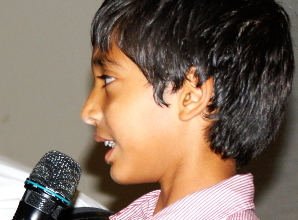Steps to Successful Singing!
Just use the and icons to navigate!
What's in this Book?
Did you know that the language of music is developed by singing?? Everyone can "speak" this language! Find out how students as young as three can nurture their love for this amazing universal language of song and take the first steps to successful singing!
What's the best way to get started in successful singing? Make sure it's FUN! This tiny book outlines some recommended simple steps for your singing journey in preparation for (or in addition to) customized Private Lessons.
- STEP #1: Family & EMA Classes
- STEP #2: All Arts Vocal/Drama
- STEP #3: Vocal Ensemble I
- STEP #4: Vocal Ensemble II
- STEP #5: Private Lessons!
Of course, you can always jump in where you are or skip straight to Private Lessons!

My First Step in Singing? FUN!
Turn the page to join us on a journey to help discover the right singing classes or lessons for your singer.
Start the jouney with singing!
Some children begin singing even before their spoken language emerges at around age 2, but in those early ages (2-4) little singers are not quite ready for classes that focus on just one thing (i.e., singing) so how can we make it FUN?
We have the perfect solution! Offer music classes for these younger ages that change subject every 3-7 minutes AND include 40% singing in some form. This keeps my child engaged, enhances singing without pressure while buying some developmental time to be ready for a classes that focuses ONLY on singing. We call this award-winning class "EMA" or Early Music Awareness. In this trademark class, your young child ages 1-3 or 3-5 begin their "formal" learning in an informal, fun and fast-paced environment.
Learn more about Early Music Awareness
My parents sing with me!
If even before birth parents can impart a sensitivity to music by singing, how much more can a singing parent instill passion in a toddler?
Family and EMA Classes
If your young singer is between 6 to 36 months, you'll want to join one of our toddler-parent participation classes. These classes are a wonderful opportunity for a special time of bonding with your child in a warm, encouraging environment.
In addition to singing, movement and rhythm games, classes include symphonic and ethnic instrument exploration in which parents and children have the opportunity to handle and play real instruments and even learn about notes (mostly for the parents!) in a fun 30-minute format. EMA Family classes are limited to six families. (Siblings enrolled in other classes may attend at no charge.)
Find Family and EMA classes!
Introduce the world of music!
In my class, I sing in SO many ways--with movement, rhythm games and instruments to keep me excited.
All Arts Vocal Drama
When children first start singing, especially if they LOVE to sing, they may not care if they are singing accurately (or even recognize if they are.) All Arts gives them an opportunity to sing their hearts out without fear of inaccuracy (but with help toward it!)
These energetic classes for ages 4-7 include songs, gestures, a little bit of drama, simple costumes and fun accessories. Performances include sound tracks with other children's voices to help them sound great while they apply their developing skills of stage presence, poise, audience courtesy, using microphones and just being their cute selves on a stage--often for the first time.
Find an All Arts Class!
Step #2: All Arts Vocal/Drama
The performance personality finds a stage!
Vocal Ensemble Level I
Once young singers can read, they build on their growing performance skills from All Arts and are ready to begin working more on singing technique and blending voices.
Available for singers ages 6-10, students learn to care for the voice with proper breathing, build articulation skills and prepare performances using songs from musical theater and contemporary repertoire. They are presented with minimal accompaniment to showcase the beauty of the choral sound.
Find a Vocal Ensemble!
Step #3: Vocal Ensemble I
We focus on healthy singing and the beauty of our sound together.
Vocal Ensemble Level II
Available for ages 9 & up the next step for singing students may be Vocal Ensemble II. Many of these students are taking weekly private vocal or instrumental lessons, but are still anxious to enjoy the sounds and socialization of this smaller group
Similar to Ensemble I, a strong emphasis on technique allows older students the opportunity to build skills in harmonizing, blending and singing solos. To encourage the development of this music language, students who take weekly private lessons may receive a package discount on vocal groups.
Find a Vocal Ensemble II !
Step #4: Vocal Ensemble II
In addition to annual recitals, young singers are encouraged to share their gifts through community outreach performances at senior centers where the best and most appreciative (and forgiving) audiences enjoy their visits.
Private Lessons
Students can learn basics of singing in either group or private lessons, but when they are ready for a customized personal attention from a voice specialist, private lessons are the perfect solution.
Because the basics of learning to sing (breathing, articulation and presentation) are the same for everyone, learning the basics of singing is often just as effective (and more FUN!) in a group, but private and semi-private (2-1) lessons allow students to choose songs that are of the most interest to them and highlight their singing range and style. They may also choose an "adjudicated" (or examinations) path with syllabus levels such as that which is offered through Royal Conservatory.
Request Private Voice Lesson options!
Final Step: Private lessons!
My private teacher helps me choose the songs that fit my interest, range and style and then teaches me how to sing them well.
~Jill T.
~Jill T.
~Rosy H.


